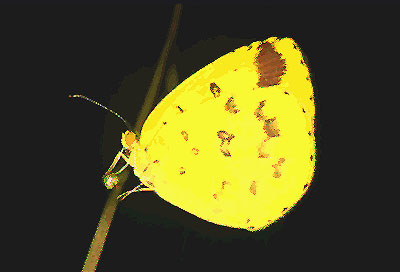




 |
Order
- LEPIDOPTERA
(Greek, lepid = scale; pteron = wing)
Common Names: moths and butterflies
Distribution: Cosmopolitan
Suborders: Zeugloptera and Glossata
Description
Most species within the Lepidoptera are readily distinguished by the
characteristic coiled proboscis used for nectar feeding. Large compound
eyes and simple eyes (ocelli) are frequently present. Two pairs of wings
are present and these are often brilliantly coloured or have spectacular
patterns or shapes. The colours are produced by minute scales which cover
the wing surface and give rise to the order name.
At rest, moths usually carry their wings spread flat or held together to
resemble the sloping sides of a house roof; butterflies usually carry
their wings held flat together over the body. Butterflies are more active
during the day while moths are more active from dusk and onwards into the
night hours. The antennae are smooth and terminate in small clubs in all
butterflies, while in moths, the antennae are usually comb or brush-like.
Mating in most species involves sex scents (pheromones) to attract the
males to the females.
Larva
The life cycle always involves metamorphosis from egg to larva (caterpillar)
to pupa and finally adult insect. The pupa or chrysalis may be protected by a
cocoon of silk threads or be naked and simply suspended from a leaf or stem.
Members
Moths, butterflies.
Food
Living plant tissue is most commonly eaten by most caterpillars. However,
some species are predators (for example one species infests green tree ant nests
in tropical Australia) and still others are scavengers on such materials as
wool. Adults are mostly nectar feeding but will also take honeydew or sugar rich
plant exudates. Some species are known to use nitrogenous animal wastes.
Importance
Both moths and butterflies are extremely important as pollinators, and they
also form a very useful part of the food chains of insectivores (spiders, birds,
geckoes, etc.). Various species are extremely important pests and cause large
amounts of damage to various crops: bananas, cacao (cocoa), citrus, coconut,
coffee, maize, potato, rice, sugar cane and tomato.